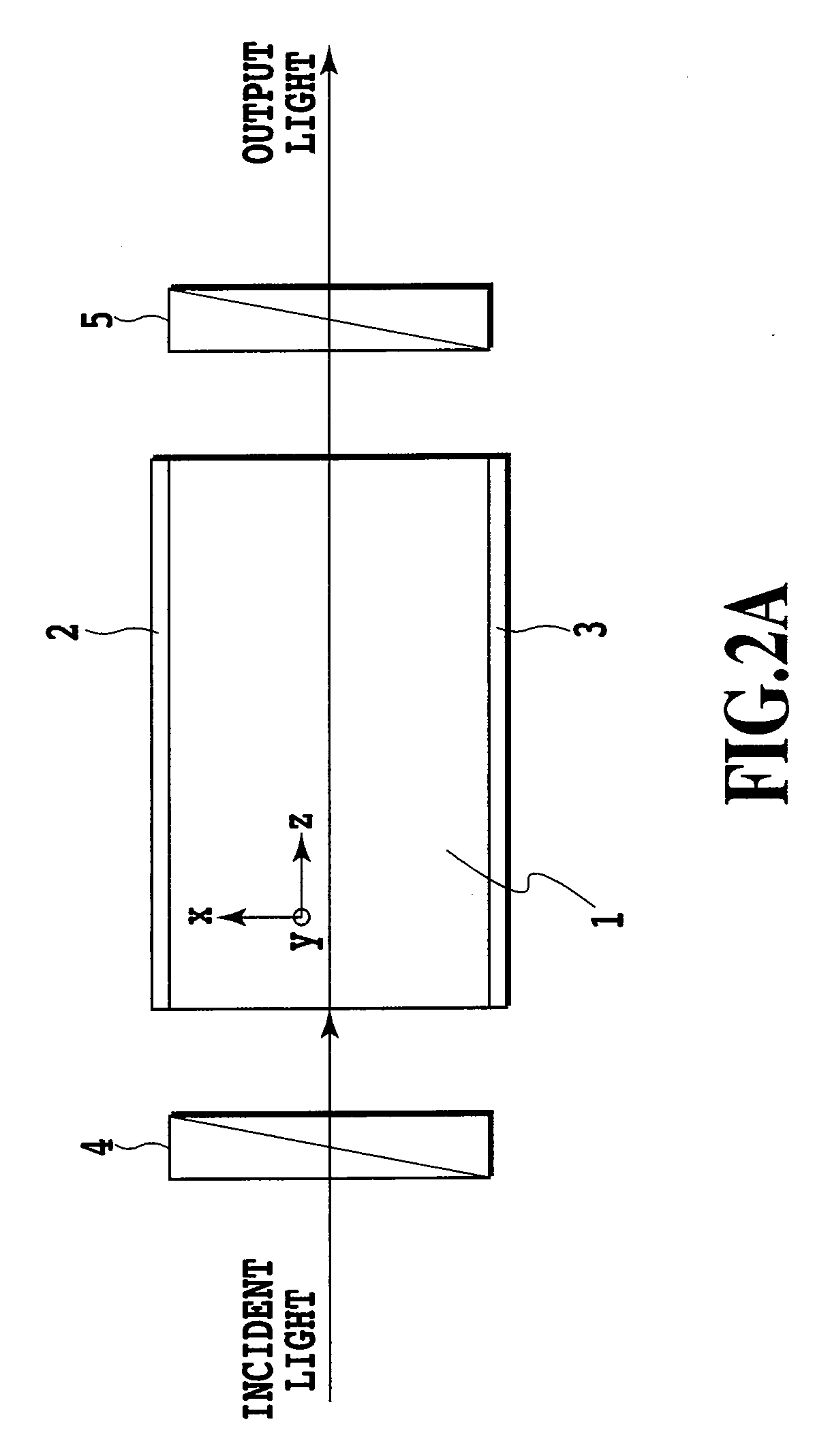Electrooptic device
a technology of optical deflectors and optical deflectors, applied in the field of optical deflectors, can solve the problems of limited rotational speed, inadequacies of polygon mirrors, and inability to meet the requirements of rapid operation, and achieve the effects of reducing the angle of shifting between vertically polarized light and horizontally polarized light, reducing beam deflection, and increasing beam deflection
- Summary
- Abstract
- Description
- Claims
- Application Information
AI Technical Summary
Benefits of technology
Problems solved by technology
Method used
Image
Examples
embodiment 1
[0110]FIG. 15 shows an electrooptic device of a parallel-plate electrode type according to embodiment 1 of the present invention. A KLTN crystal (in K1-yLiyTa1-xNbxO3, x=about 0.40 and y=about 0.001) is cut in the shape of a rectangle, and an electrooptic crystal 11, of which four faces are polished, is prepared. A positive electrode 12 and a negative electrode 13 made of Ti / Pt / Au are formed on the upper face and the lower face of the electrooptic crystal 11. The size of the electrooptic crystal 11 is 6 mm (z axis)×5 mm wide (y axis)×0.5 mm thick (x axis), and the size of each electrode is 5 mm long×4 mm wide. In this specification, Ti / Pt / Au is used to indicate that Pt and Au are laminated, in this order, on a lowermost layer of Ti.
[0111]The KLTN crystal is an electrooptic crystal having an electrooptic constant that is great near the phase transition from the cubic system to the tetragonal system. Since the phase transition temperature of the KLTN crystal employed for the embodimen...
embodiment 2
[0119]FIG. 18 shows qn electrooptic device of a horizontal electrode type according to embodiment 2 of the present invention. A KLTN crystal (in K1-yLiyTa1-xNbxO3, x=about 0.40 and y=about 0.001) is cut into the shape of a rectangle, and an electrooptic crystal 21 of which four faces are polished is prepared. A positive electrode 22 and a negative electrode 23 made of Ti / Pt / Au are formed on the upper face of the electrooptic crystal 21. The size of the electrooptic crystal 21 is 6 mm (z axis)×5 mm wide (y axis)×0.5 mm thick (x axis), and the size of each electrode is 5 mm long.
[0120]The KLTN crystal is an electrooptic crystal that has an electrooptic constant that is great near the phase transition from the cubic system to the tetragonal system. Since the phase transition temperature of the KLTN crystal employed for the embodiment 2 is 55° C., a Peltier device and a resistance bulb are employed to set the temperature of this device to 60° C., which is higher by about 5° C. than the ...
embodiment 3
[0126]FIG. 20 shows a light beam deflector according to embodiment 3 of the present invention. For the light beam deflector, a positive electrode 32 and a negative electrode 33 are formed on opposite faces of a block electrooptic crystal 31. The electrooptic crystal 31, which is a KLTN crystal, is cut to a size 6 mm long (z axis)×5 mm wide (y axis)×0.5 mm thick (x axis), and electrodes 5 mm long×4 mm wide are attached to the opposite faces. The relative permittivity of the KLTN crystal for this embodiment is 6300 at the measurement temperature of 20° C. Ti / Pt / Au is employed as the electrode material. FIG. 21 shows a distribution of the refractive index change in the light beam deflector for the embodiment 3 of the present invention. A distribution is shown for the fluctuation, when a voltage applied between the positive and negative electrodes is changed, of a refractive index of light that vertically advances. The vertical axis represents the change in a refractive index when no vo...
PUM
 Login to View More
Login to View More Abstract
Description
Claims
Application Information
 Login to View More
Login to View More - R&D
- Intellectual Property
- Life Sciences
- Materials
- Tech Scout
- Unparalleled Data Quality
- Higher Quality Content
- 60% Fewer Hallucinations
Browse by: Latest US Patents, China's latest patents, Technical Efficacy Thesaurus, Application Domain, Technology Topic, Popular Technical Reports.
© 2025 PatSnap. All rights reserved.Legal|Privacy policy|Modern Slavery Act Transparency Statement|Sitemap|About US| Contact US: help@patsnap.com



